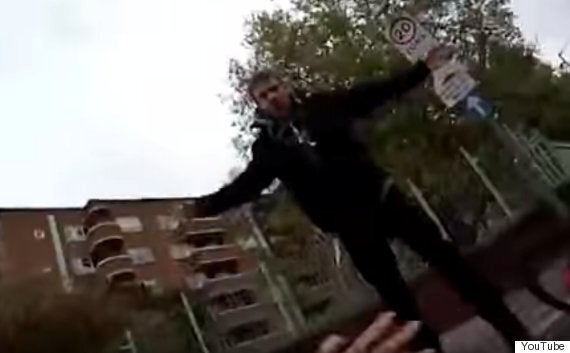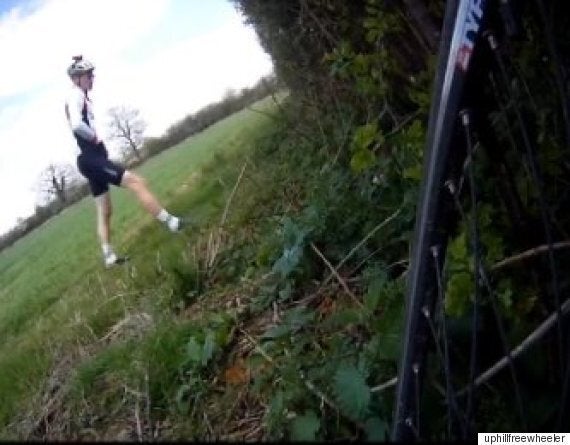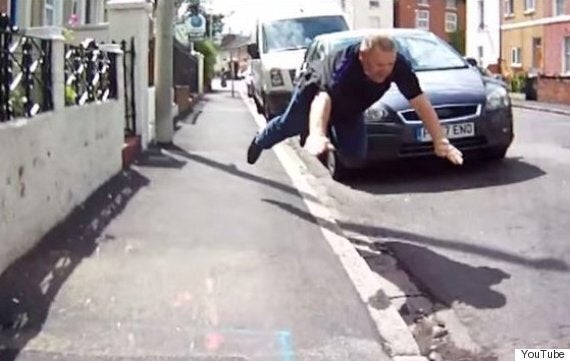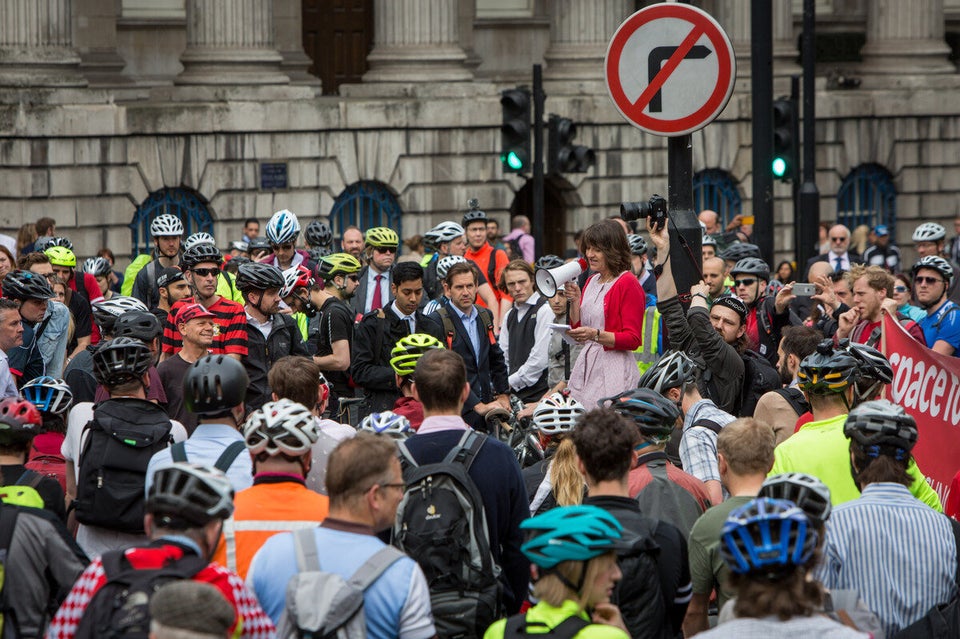"Please don't try and knock me off" was all the cyclist said as a pedestrian ambled across Sidney Street and almost into her path in Whitechapel, London.
But that's all it took.
Moments later, as her helmet-mounted camera detailed, the woman in her 40s was on her back, hand raised in defence, whimpering.
The man raged above her; arms outspread like a victorious gladiator.

A man was caught on a helmet-mounted camera pushing a woman off her bike in Whitechapel; he turned himself in hours after the video was used in media reports
"You want to put your finger up at me you mug? Come on," he said, before shoving her to the ground.
The video was circulated to media Tuesday and at 1.30pm that day the 33-year-old man turned himself in to police.
Result.
Camera captures evidence. Culprit caught. Case closed.
While the incident is a perfect example of how effective cameras are in capturing altercations, and they've become so topical that the national cycling charity, CTC, has a piece in the forthcoming edition of their magazine, Cycle, on how to "capture the right type of evidence when making a complaint to the police", authorities won't endorse them.
The issue, a Met spokesman explained after refusing to comment officially, was "too wide" with "too many implications".

The last frame of the video sees the woman's attacker hovering over her as she whimpers on the ground
Often videos of road rage altercations are uploaded to YouTube well before they're passed to police - if at all - and on the internet superhighways, its cyclists who rule, with the power imbalance often complained about on the road, super-sized in reverse.
Ian Taylor of the Alliance of British Drivers said while "not pretending all drivers are angels" there was a certain "self righteousness" about some cyclists. He said this was evident in YouTube videos showing motorists being "goaded" into misbehaving.
Taylor cited a video from Reading that emerged a few weeks before the Whitechapel incident as an example of this. It showed a cyclist acting like a vigilante. Seemingly reassured by the protection that everything was being recorded by his camera, the cyclist chases down a clearly agitated motorist and verbally entices him into more incriminating behavior. The altercation didn't turn violent, but it did go viral.

The Reading video was uploaded by a YouTube user called uphillfreewheeler who uses the above profile picture
The video was uploaded by a cyclist under the user name uphillfreewheeler who in the description field of his profile says, "Cycling around with a camera. Based in Reading." He has published numerous clips of his interactions with motorists, which he also posts on Google+. The dramatised video from July 30 entitled, "A Clown Takes A Prat Fall", has gained the most hits - over 5,000,000.
The video opens with a Peugeot 405 closing in on the camera before passing by. The cyclist is heard asking, "is that close enough", before reading out the digits of the station wagon’s registration plate as it disappears from view. The passing manoeuvre is played back, and then the footage is sped up as the cyclist gives chase.

The climax to the video of the Reading confrontation sees the motorist fall over after trying to kick the cyclist's back wheel
At a stop sign he gets the drivers attention, saying: "That was way too close."
The motorist tells the cyclist he is "lucky he didn't hit him".
He adds: "If you had the decency to go over one side and not take the whole fucken road. Are you a fucken tank? No. Are you a fucking car? No. You are a little bicycle. But you are in the middle of the road so it’s your fault if you get knocked off."
The cyclist asks the driver if that disclaimer is in the Highway Code before telling him, "I'm putting you on YouTube". The driver retorts: "Put me on where you like and I'll fucking kill you."
The cyclist says he will tell the police. The driver uses the word "fuck" a few more times.
The cyclist changes tact. "Why aren't you wearing a seatbelt"?
The driver gets out of his car and covers the camera with his hand. "Get a fucken life or I'm going to sort you and your fucken camera out."
The driver gets back in the car, but the camera keeps rolling. He then approaches the vehicle telling the driver he assaulted him, before imploring him to "put his seat belt on".
The driver replies, "put your fucken mouth shut", a line ceased upon in media reports of the altercation and one that led to several musical re-mixes of the video (there are more than a dozen).
The clip ends climatically with the driver chasing his taunter and falling to the ground (taking a pratfall) after trying to kick the man's tyre as he cycles away.
David Murray, the communications manager of the national cycling charity, CTC, said cyclists' behaviour on the roads was reflective of their vulnerability. He likened near misses and collisions to motorists' "holding a loaded-gun to your head" and then pulling it away.
He said: "A car is a weapon and it can kill, that's why cyclists get angered so quickly."
When videos of altercations are posted online often the consequences for those involved are far more severe than if the matter goes before a court.
Stephen Perrin uploaded a video in 2013, which showed him being knocked off his bike, and repeatedly punched by a van driver in Birmingham. While not charged by police the motorist involved suffered unduly in the court of public opinion after being identified by locals.
Perrin told The Guardian at the time: "I put the video online because it needs to be seen, but the grief he and his family have got since from trolls and the like disgusts me."
The consequences of the driver's actions got "out of hand" after former Olympic champion Chris Boardman saw the video and passed on the link to his 80,000 Twitter followers, querying why police didn't lay charges. The motorist was made to apologise to Perrin and pay him compensation.
Perrin said: "The driver has a small business and I don't want to see him run out of town because of the abuse he's getting. Obviously what he did that day was his fault and I do feel there should have been criminal consequences for it, but a few idiots online always take things too far."
One thing motoring and cycle safety groups agree on is that filming incidents can escalate minor roadside disagreements into physical confrontations.
Taylor: "Some people would say it would subdue behaviour, but it can also provoke the opposite... it depends on the people involved."
He said helmet cameras gave motorists the impression that cyclists were "out to get them" and were trying to pick up on "any point". In May last year Lewis Dediare made headlines and earned the nickname "Traffic Droid" after he mounted seven cameras to his helmet and bike and travelled around London recording traffic crimes. He then uploaded his evidence to YouTube and Twitter as well as passing it on to police.

Lewis Dediare covered his helmet in cameras to collect evidence of traffic crimes which he then uploads online and passes on to police
Other road rage videos to have circulated in the media this year show just how heated arguments between cyclists and motorists can get.
In June a video emerged showing butcher Jason Wells threatening to "fucking kill" a cyclist after an incident in Richmond Park, London. The video has since been removed from YouTube.
And In January a cyclist was assaulted after being knocked off his bike by a van driver who he had earlier told to "get off your phone you muppet". YouTube records that the original video of the incident was removed over a "privacy complaint".
Taylor says: "Anyone full of rage, circling around and shouting at vehicles they're stupid by doing that. They're creating a dangerous situation for themselves and the driver."
Motorists and cyclists have always had a difficult relationship. The debate around the issues, Dr Ian Walker, a psychologist at Bath University, told The Guardian bared comparison with the treatment of so-called societal out-groups,
In July he told the newspaper: “What you see in discourses about cycling is the absolute classic 1960s and 1970s social psychology of prejudice.
“It’s exactly those things that used to be done about minority ethnic groups and so on – the overgeneralisation of negative traits, under-representation of negative behaviours by one’s own group, that kind of thing. It’s just textbook prejudiced behaviour.”
Londoners love cycling. According to British Cycling the gold-medal performances of Victoria Pendleton and Laura Trott alone helped encourage 250,000 more women to start regularly cycling since the 2012 Games. From 2000 to 2012 the number of daily journeys made by bicycle in Greater London is thought to have doubled to around 580,000.
Story continues below
The CTC records that 8% of the population aged five and over cycles three or more times a week - around 4.6 million people. And the latest census data, from 2011, shows that the number of London residents cycling to work has more than doubled in the last decade.
Despite the mode of transport's popularity cycling in London is widely considered to be unsafe. Helmet cameras, says Murray, give cyclists a "sense of safety" as they are "capturing what is going on".
He estimated that "hundreds if not thousands" of cyclists now use them with the technology becoming increasing popular over the last 12-18 months as the cost of cameras halved. A GoPro now costs about £250. Taylor said as a consequence motorists were now increasingly mounting cameras to their dashboards.
Murray says cycling is made out to be "much riskier than it is" in London - population 8.6 million - where there has been eight deaths so far in 2015.

Cyclist Ying Tao was killed after being crushed by a tipper truck at Bank
He said: "You're more likely to get injured doing an hours' gardening than cycling for an hour," before adding: "You'd need to cycle 27,000 times around the world for every death that occurs."
The last cyclist to die in London was Ying Tao, a 26-year-old Cambridge graduate who was crushed under the wheels of a tipper truck near Bank junction. According to London Cycling Campaign tipper trucks are involved in 50% of deaths involving cyclists in the city. The group wants them banned from minor roads and from operating during the morning rush hour.
A protest was held over Tao's death with thousands of people gathering at Bank to stop traffic. The demonstration followed a mass "die-in" in Camberwell weeks earlier to mark the death of Esther Hartsilver who was struck by a lorry in Denmark Hill on May 29.
In 2014 there were 13 fatalities in London involving cyclists. In 2012 there were 14.
Last year 113 cyclists died in Britain according to the Department for Transport's annual road safety statistics. The previous year the death toll was 109. A decade ago there were 134 deaths.
So while London hogs the headlines for cycling safety the pursuit is much more dangerous in rural areas. But while deaths are falling, serious injuries are not. Last year they jumped 8.2 per cent to 3,401 in the UK.
SEE ALSO
According to The Telegraph they have increased in nine out of the last 10 years, and are up significantly from 2,174 serious injuries in 2004.
Taylor said "irrespective" of what happens on the roads' both cyclists and motorists should never "charge up" to each other, saying: "Road rage by anyone is never a good idea."
The answer Murray says is simple. Driver's needed to "respect the more vulnerable party".
